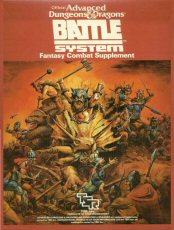Contents
Battlesystem was first released in 1985, compatible with either Advanced Dungeons & Dragons or the Basic / Expert Dungeons & Dragons (see editions of Dungeons & Dragons). The game was promoted as a successor to the medieval miniature wargame Chainmail. [1]
In a Battlesystem game, each miniature represents a hero, a commander, or multiple troops, depending on the troops' level or hit dice. [2] There are no statistics in the game for any troops or characters, but, instead, all are derived from the relevant Dungeons & Dragons publications. For instance, to add any creature from the Monster Manual or similar publications as troops, its in-game point cost can be derived from the XP reward listed in the Monster Manual for killing the creature. [3]
The first edition of Battlesystem was a set of rules and components for use in playing mass fantasy battles, involving miniatures rules for metal or cardstock figures, or counters. [4] The first edition set contained rules with beginner and intermediate levels of complexity, four battle scenarios, a guide to miniatures, a number of cardboard figures, and over 800 counters. It was meant to be used with either the Advanced Dungeons & Dragons game or the simpler Dungeons & Dragons rule book sets available at the time. [4]
The first edition of Battlesystem was sold as a box set which contained: [5]
- 32-page rule book
- 24-page scenario book
- 16-page guide to miniatures
- 2 Player Aid Cards
- 2 Metal Miniature Generals
- 3-D Adventure foldup Figures
- Army Roster Sheets
- 801 die-cut counters
The Rulebook is divided into four parts, allowing three levels of play. The first part is an introduction. The second part, called "The Basic Game", covers the basic rules of movement and melee combat. [6] The third part, "The Intermediate Game", adds missiles, artillery, cavalry, individual Heroes, special formations and terrain effects. [7] The fourth part, called "The Advanced Game", allows for magic, flying, weather, night battles and special monsters. It also introduces campaign rules that allow for integration of Battlesystem games into a role-playing campaign. [8] The game does not require a Dungeon Master, although the Rulebook recommends use of a referee, especially if using certain magics such as invisibility or illusions. [9]
The Scenario Book contains four scenarios. Three of the scenarios form a linked campaign in a generic fantasy setting, one for each level of the game. The fourth is an advanced game scenario for Dragonlance, Battle of Qualinost. It takes place during the same time period as DL2 Dragons of Flame, while the heroes are in Pax Tharkas. [10]
According to the game's rules, it was designed to be played with either 25 mm or 15 mm miniatures. The game, however, does not require a certain size of miniatures. The official Battlesystem miniatures released at the time, except for two in the box set, were all 15 mm. At the time, many companies producing 25 mm figures were starting to make larger figures, sometimes even officially called as 'Heroic 25 mm' or 28 mm, that were difficult to fit or didn't fit on the official Battlesystem base sizes.
Reception
Roger Musson reviewed the original boxed set in Imagine magazine, giving it a positive review. [11] He noted that the rules are fairly easy to use, although there are "some omissions and rules buried in odd places". [11] Musson thought that "no self-respecting DM will want to be without the Battlesystem rules", although he found the other contents of the box of somewhat mixed value. [11] Overall, Musson felt that the package is "to be welcomed" and that it "may provide a good introduction for many to the world of fantasy-wargaming". [11]
Graeme Davis reviewed the original Battlesystem for White Dwarf , giving it a rating of 8/10 overall. He called the rules "concise and well-written". [12] He felt that as a supplement to the D&D game, "the Battle System does what it sets out to do and does it very well; it may not be as detailed as some fantasy wargame rules, but it is adequate for the requirements of most role-players and can be used quite easily by anyone familiar with D&D or AD&D". [12] Davis concluded by stating that "Battle System deserves to be given a chance, but I'm afraid that it may have priced itself out the market from the start." [12]
Scott Dollinger reviewed Battlesystem for Different Worlds magazine and stated that "two good things did come out of Battle System. The first is that TSR is now producing some fine modules for large-scale combats. Even if one does not use Battle System the modules have a great deal of appeal for those individuals who enjoy simulation games as well as the role-playing variety. Second, the areas left undeveloped in Battle System make great article ideas for impoverished writers such as myself." [13]
The original Battlesystem set won the H.G. Wells award. [4]
